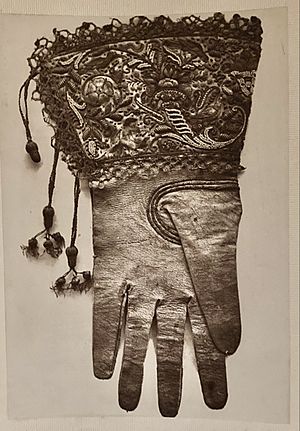Isabel Agnes Cowper facts for kids
Isabel Agnes Cowper (born Thompson; 7 July 1826 – 17 February 1911) was a British wood-engraver and photographer. She made history as the first female Official Museum Photographer at the South Kensington Museum. This museum is now known as the Victoria and Albert Museum in London. She might even have been the first female Official Museum Photographer anywhere!
From 1868, when Cowper started her job, until she retired in 1891, she took thousands of photos. These pictures showed objects in the museum, items loaned to it, and even the construction of the museum buildings. During her lifetime, her photographs were used widely in museum books. Today, her work is still being found in libraries and archives around the world.
Contents
Early Life and Education
Isabel Cowper was born in Kensington, London, in 1826. Her parents were Harriott and John Thompson. Her father was a famous wood-engraver and taught wood-engraving classes for women at the Central School of Design. The family lived in Kensington, London.
From a young age, Isabel and her four siblings (Charles, Richard, Eliza, and Augusta) were skilled wood-engravers. They learned their craft by working with their father.
In 1841, Henry Cole, who founded the South Kensington Museum, hired Isabel and her sisters. Cole believed wood-engraving was a good career for women. They engraved pictures for his guidebooks about Westminster Abbey and Hampton Court Palace.
Cowper created many wood engravings for different books. These included Cole's guidebooks, a fairytale called The King of the Golden River by John Ruskin, and children's stories collected by Richard Doyle. Some of Cowper's wood-engravings are now part of the Victoria and Albert Museum collection.
Marriage and Family
On 30 March 1852, Isabel married Charles Cowper. They moved to 4 Campden Hill Terrace in Kensington. Charles was a chemist who worked for a glass company called Chance Brothers. This company made glass for windows and photography. Later, he started his own business as a patent agent, helping people protect their new inventions, especially in photography.
Isabel and Charles had two sons and two daughters. Charles died on 23 December 1860, when Isabel was pregnant. Isabel inherited his estate, which was worth over £4000.
Career at the South Kensington Museum
We don't know much about Isabel Cowper's life between her husband's death in 1860 and 1868. That's when she became the South Kensington Museum's Official Museum Photographer. It's not clear where or how she learned photography. However, she likely learned from her brother and her husband.
Records show that in 1867, Cowper was in Paris with her brother, Charles Thurston Thompson. He was the museum's first Official Museum Photographer. This suggests she was already working with him.
When Thurston Thompson died in January 1868, his widow suggested Isabel Cowper for the job. On 10 February 1868, Cowper applied. By March of that year, museum records show "Mrs. Cowper" delivering photographic prints and negatives to the studio.
By 1871, Cowper lived at 3, The Museum Residences. This was housing at the South Kensington Museum for important staff members. She lived there with her four children (Sidney, Beatrice, Richard, and Ada), her two sisters (Eliza and Augusta), and her brother Richard. Richard later became the Assistant Director of the museum. They also had two servants.
As the Official Museum Photographer, Cowper managed the museum's photo studio. She oversaw the creation of thousands of collodion on glass negatives. Many of her original glass negatives are still kept in the V&A archive today.
Cowper's negatives were used in many ways:
- They were used to print albumen positives (a type of photo print).
- They helped create illustrations for museum books. These books were sent to art schools, galleries, and museums worldwide.
- They were collected in the National Art Library for artists and scholars to use.
- They were sold to the public at the museum.
- They were used as examples for still life exams in the national school curriculum.
- They were made into lantern slides for museum experts to use in lectures.
Isabel Cowper also gave expert advice on photography. For example, she advised on photographing the famous Bayeux Tapestry. She also advised on how to store and insure the museum's large collection of glass negatives.
Cowper showed her photographs at the International Fairs in 1871, 1872, 1873, and 1874. Art newspapers praised her work. She was especially known for her excellent skills in photographing lace and textiles. She also registered her photos for copyright and photographed Henry Cole's children.
Cowper signed all her glass negatives. This likely helped her keep track of her work for payment. When she started, she was paid 3 pence for every square inch of glass negative she made. As a woman, Cowper could not join the civil service, where most male museum staff worked. So, for all 23 years she worked at the museum, she was paid as an outside contractor, based on how much work she produced.
Retirement and Death
In 1891, her brother Richard, the museum's Assistant Director, retired. Cowper then also submitted her retirement to the Museum Director, Captain Donnelly. Her retirement became official on 31 December 1891.
Cowper moved with her brother to Sutton in Surrey. After Richard died in 1908, Cowper moved to Glasgow, Scotland. She lived at 9 Derby Crescent with her married daughter, Beatrice Hedley. Isabel Cowper died on 17 February 1911 in Glasgow. She was 85 years old. She is buried with her parents, brothers, and three of her children in Kensal Green Cemetery.


